JavaScript is disabled for your browser. Some features of this site may not work without it.
Buscar en RiuNet
Listar
Mi cuenta
Estadísticas
Ayuda RiuNet
Admin. UPV
Municipal solid waste generation in mature destinations: An IPAT-type model for Mallorca
Mostrar el registro sencillo del ítem
Ficheros en el ítem
| dc.contributor.author | Arbulú, Italo
|
es_ES |
| dc.contributor.author | Lozano, Javier
|
es_ES |
| dc.contributor.author | Rey-Maquieira, Javier
|
es_ES |
| dc.coverage.spatial | east=3.0175712000000203; north=39.6952629; name=Carrer Arraval, 07430 Llubí, Illes Balears, Espanya | es_ES |
| dc.date.accessioned | 2019-03-11T11:51:44Z | |
| dc.date.available | 2019-03-11T11:51:44Z | |
| dc.date.issued | 2013-06-07 | |
| dc.identifier.issn | 1578-0732 | |
| dc.identifier.uri | http://hdl.handle.net/10251/117960 | |
| dc.description.abstract | [EN] Several studies examined the relationship between environmental degradation and population growth. However, most of them don’t take into account the difference between local population and tourist arrivals. This paper contributes to the literature by separating these two groups within the framework of IPAT-based models to measure the impact of tourist arrivals in terms of municipal solid waste generation for Mallorca. The model leads to a stochastic differential equations system, which showed that this mature tourist destinations have higher population elasticity than industrial economies. Moreover, the model allowed us to measure the elasticity of substitution between lower-income and higher-income tourists. | es_ES |
| dc.description.abstract | [ES] Varios estudios examinaron la relación entre la degradación ambiental y el crecimiento demográfico. Sin embargo, la mayoría de estos no consideran la diferencia entre población local y turística. Este trabajo contribuye a la literatura mediante la separación de estos grupos en el modelo IPAT para cuantificar el impacto del turismo en la generación de residuos sólidos urbanos en Mallorca. Éste conduce a un sistema estocástico de ecuaciones diferenciales que muestra que destinos maduros tienen mayor elasticidad de población que las economías industriales. Además, el modelo permite medir la elasticidad de sustitución entre turistas de bajos ingresos y de mayores ingresos. | es_ES |
| dc.description.sponsorship | The authors would like to mention our gratefulness to TIRME S.A. for their trust, financial support and data source. | es_ES |
| dc.language | Inglés | es_ES |
| dc.publisher | Universitat Politècnica de València | |
| dc.relation.ispartof | Economía Agraria y Recursos Naturales - Agricultural and Resource Economics | |
| dc.rights | Reserva de todos los derechos | es_ES |
| dc.subject | Modelo IPAT | es_ES |
| dc.subject | Residuos sólidos municipales | es_ES |
| dc.subject | Crecimiento turístico | es_ES |
| dc.subject | IPAT Model | es_ES |
| dc.subject | Municipal solid waste | es_ES |
| dc.subject | Tourism growth | es_ES |
| dc.title | Municipal solid waste generation in mature destinations: An IPAT-type model for Mallorca | es_ES |
| dc.title.alternative | Generación de residuos sólidos municipales en destinos maduros: un modelo tipo IPAT para Mallorca | es_ES |
| dc.type | Artículo | es_ES |
| dc.date.updated | 2019-03-11T11:26:46Z | |
| dc.identifier.doi | 10.7201/earn.2013.01.04 | |
| dc.rights.accessRights | Abierto | es_ES |
| dc.description.bibliographicCitation | Arbulú, I.; Lozano, J.; Rey-Maquieira, J. (2013). Municipal solid waste generation in mature destinations: An IPAT-type model for Mallorca. Economía Agraria y Recursos Naturales - Agricultural and Resource Economics. 13(1):69-93. https://doi.org/10.7201/earn.2013.01.04 | es_ES |
| dc.description.accrualMethod | SWORD | es_ES |
| dc.relation.publisherversion | https://doi.org/10.7201/earn.2013.01.04 | es_ES |
| dc.description.upvformatpinicio | 69 | es_ES |
| dc.description.upvformatpfin | 93 | es_ES |
| dc.type.version | info:eu-repo/semantics/publishedVersion | es_ES |
| dc.description.volume | 13 | |
| dc.description.issue | 1 | |
| dc.identifier.eissn | 2174-7350 | |
| dc.contributor.funder | TIRME, S.A. |








